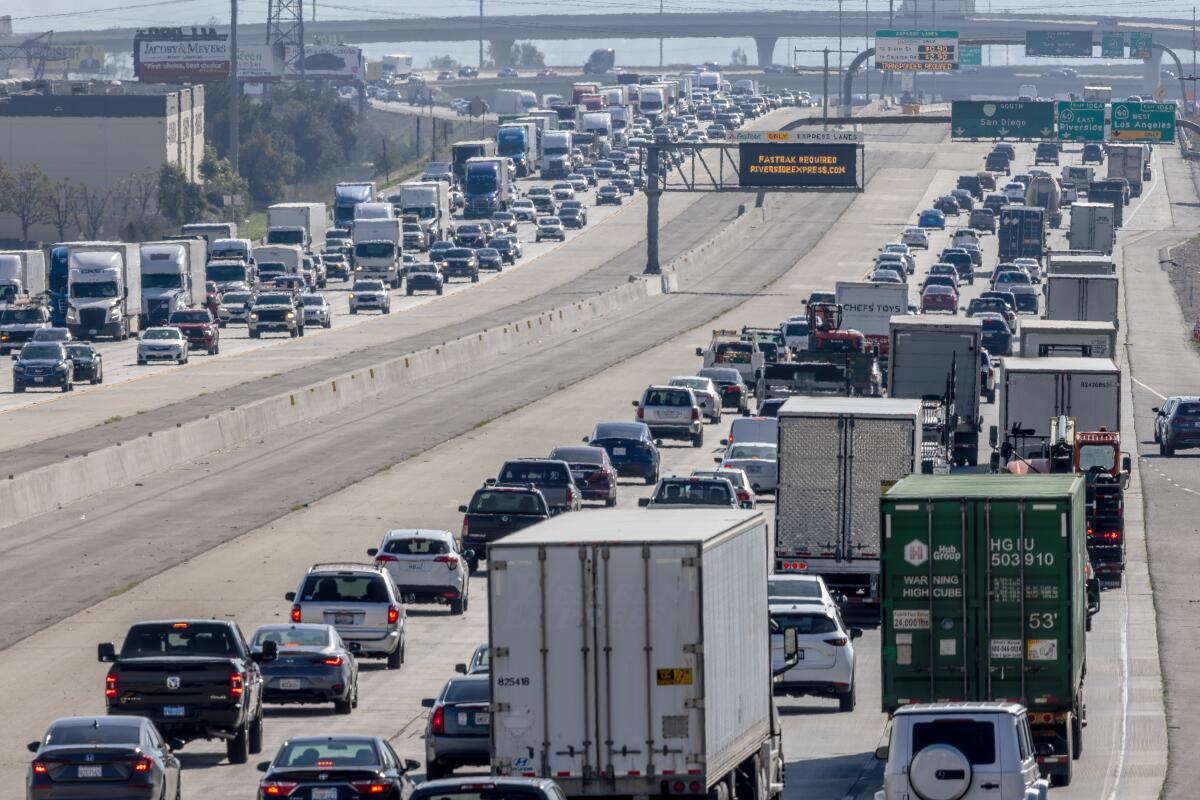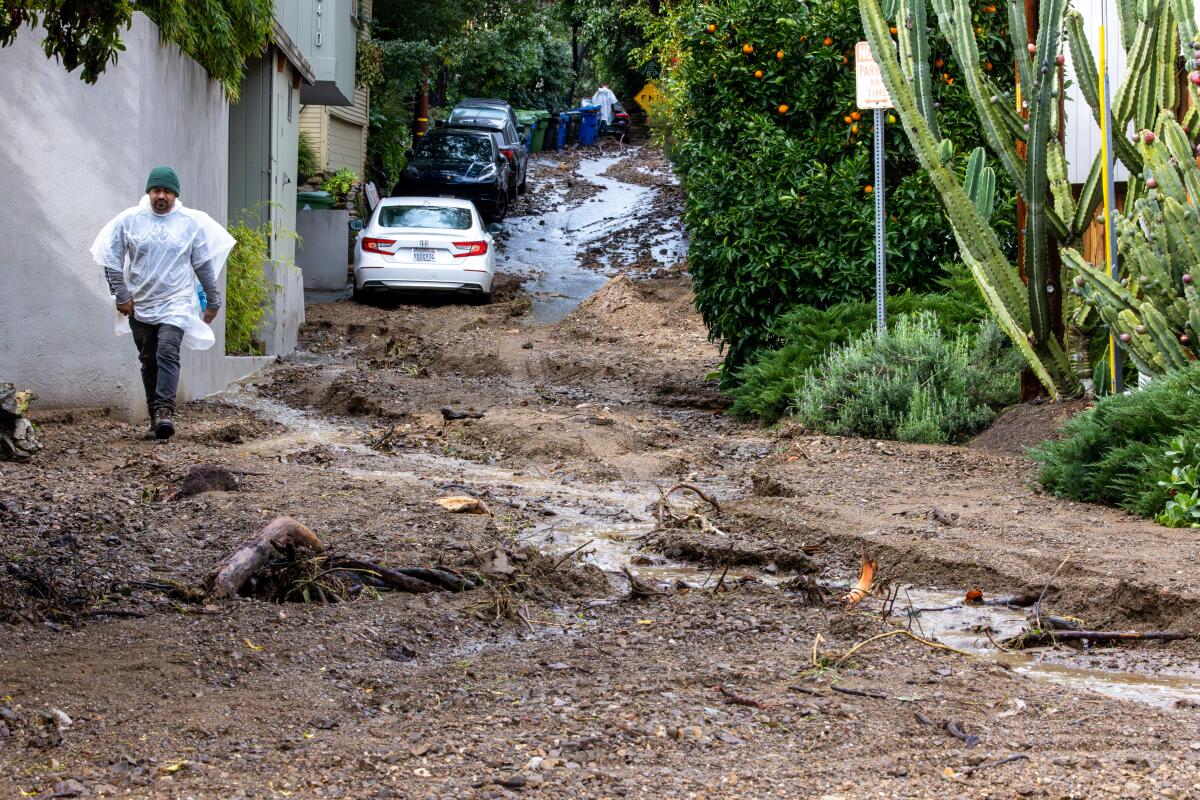We can’t widen our way out of traffic congestion. So why are we still adding lanes?

Good morning. It’s Wednesday, Feb. 7. Here’s what you need to know to start your day.
- We can’t widen our way out of traffic. So why are we still adding lanes?
- A D.C. court rejects Trump’s claim of presidential immunity
- Inside L.A.’s invite-only mom group that’s better than Google
- And here’s today’s e-newspaper
Sign up for Essential California
The most important California stories and recommendations in your inbox every morning.
You may occasionally receive promotional content from the Los Angeles Times.
Fixing traffic? Just a few more lanes should do it, right?
This is the familiar promise for traffic-clogged freeways — and one that is provoking controversy in the Inland Empire:
Transportation officials say commuters will benefit when express lanes are added to the truck-clogged Interstate 15, burdened with diesel-burning big rigs traveling to and from mammoth distribution centers.
The California Transportation Commission approved the project last month — overturning an earlier vote that stalled the project when concerns surfaced over potential environmental harm. The lead-up to the final decision was contentious. The commission voted to limit everyone’s speaking time and one commissioner, who had raised objections about the environmental analysis, was unable to show a lengthy presentation outlining his objections.
The episode “exposed a deepening rift in the state between its climate goals and the list of freeway widening projects that some say are gliding through without scrutiny and threatening the health of the people who live near them,” Times reporter Rachel Uranga wrote this week.
And now the U.S. Environmental Protection Agency is investigating allegations that state and local transportation officials presented flawed data that misled federal regulators in a decade-old project that had widespread support from federal, state and local agencies.
If one of the state’s goals is to reduce car travel in an effort to reduce harmful emissions, how does creating more space to drive cars help?
To unpack this, I spoke with Jeanie Ward-Waller, a former Caltrans executive and whistleblower. Last year, she accused the agency of skirting regulations to expand roads and was subsequently demoted. She’s since left the agency.
“There is definitely a lot of rhetoric [and] conversation and commitment for change, but I think there is still a lot of momentum behind particular projects,” Ward-Waller said. “Once you have some funding ... it’s kind of off and running, and it’s often hard to stop the momentum of that project as it was conceived in early stages or to reimagine or to pivot.”
Does widening freeways work?
It can — for a while. But decades of studies point to a paradox at the heart of our quest to conquer soul-sucking traffic, technically known as induced demand.
Basically, when we build more lanes for cars, there’s initially more breathing room for regular commuters. But when the perception that “traffic isn’t as bad now” takes hold, more people decide to drive at peak times, and traffic is again slowed — this time with more cars.
This concept is on full display with the 405 Freeway. In 2011, county transportation officials heralded a widening project that would make driving less hellish through the infamous Sepulveda Pass. Traffic improved briefly with the new lanes. But drive it now and it’s even slower than before.
Induced demand isn’t a foreign concept to state and local transportation planners. But some researchers say agencies’ estimates of how much induced travel a widening project will cause are often wildly inaccurate — if those estimates are included at all. What’s more, one transportation expert said, it is unclear how new express lanes will affect induced demand.
And more traffic spews more harmful emissions.
If widening doesn’t work, why are we still doing it?
That’s the multibillion-dollar question. Some people who study transportation or work(ed) for government agencies point to a few key factors.
First, as Ward-Waller explained, is the deep-seated culture at Caltrans of “wanting to build more things.”
“That is an engineering mindset and culture that is very strong at Caltrans,” she said.
Second, there’s political pressure to do something about traffic. Tied to that is additional pressure from organized labor to keep construction jobs plentiful with the widening projects that provide a reliable source of work for thousands. That’s a big reason some trade unions stand opposed to policies and legislation aimed at rethinking freeway expansions across the state.
“There is still a fear about losing a type of project that has been really important to supporting the industry’s growth over time,” Ward-Waller said, “and it’s seen as a threat.”
Then there’s public perception. Transportation and the resulting impacts are complex layers in our daily lives, Ward-Waller said, and it’s a challenge to help everyday commuters look beyond building more as the solution.
We’ve all driven on a freeway and seen the obvious signs of construction — orange cones, work vehicles, the sign proclaiming here are your tax dollars at work. For many, this might signal that something is being done to improve the roadway, and possibly our commutes in the process.
But those road signs don’t leave a lot of room for nuance, as Ward-Waller explained:
“It’s complicated, and so that’s part of the challenge. The easy and obvious solution… that occurs to people is ‘well, we should widen because there’s so much demand here.’ But it’s hard to conceptualize that that’s not actually going to fix your problem long term.”
What would actually work?
One approach that’s been successful elsewhere is congestion pricing: charging people to use certain roads at certain times.
L.A. Metro officials are currently studying how to try that out here, seeking to launch a pilot program in 2028 (maybe).
But even though studies of European and Asian cities that have implemented pricing models show promise, it will undoubtedly prove a hard sell in car-dependent California.
Ward-Waller pointed to New York City as the best test of the public’s ability to give congestion pricing a real shot. Officials are expected to move forward with a plan to charge drivers $15 or more per day, depending on the kind of vehicle, to enter heavily congested Manhattan.
“If they can’t do it in New York, where 40% of trips are taken by the subway … you probably can’t do it anywhere in the U.S.,” she said.
Today’s top stories

California storm
- Death toll at 9 as storm destruction mounts in Southern California.
- Pounding rains force millions of gallons of raw sewage to spill from L.A. County sewers.
- ‘I was flooded out’: L.A. shelters near capacity as the unhoused seek refuge from storm.
- Forecasters said L.A. would get a monster storm. It was even worse than expected in some areas.
- Here’s how much it rained in California.
- Read full coverage of the California storm.
Crime and courts
- A D.C. appellate court rejected Trump’s claim that he is immune from prosecution on criminal charges that he plotted to overturn the 2020 election results.
- Jonathan Majors’ high-profile assault and harassment case has hit yet another delay — this time in his sentencing.
- LAPD chief says he has ‘concerns’ about the police shooting of a man who held a plastic fork.
- L.A. County paid out nearly $1 billion last year in claims, reports show.
- ‘Daylighting,’ a new law that California drivers must know to avoid a ticket next year.
- A boy’s body bore the imprint of the Mercedes front grille, a medical examiner says at Grossman trial.
Sports
- Travis Kelce wants to match Taylor Swift’s Grammys win with a Super Bowl title.
- The Dodgers re-sign Clayton Kershaw, ending talk of retirement or a stint with Rangers.
More big stories
- Has California’s COVID-19 winter surge peaked? Here’s what the data show.
- Toby Keith tributes pour in after death from stomach cancer.
- Fierce competition for LAPD interim chief is like ‘Game of Thrones,’ insiders say.
- Two of L.A.’s most lauded chefs are closing their Michelin-starred restaurant and its downstairs bistro.
- A crew member dies after fall on the set of Marvel TV series ‘Wonder Man.’
Get unlimited access to the Los Angeles Times. Subscribe here.
Commentary and opinions
- Opinion: How to turn down the pressure on the southern border.
- LZ Granderson: Tracy Chapman’s gray hair represents a lifetime of authenticity.
- Jonah Goldberg: Biden’s job approval rating is abysmal. Here’s why he might beat Trump anyway.
- Bill Plaschke: Thankfully, fittingly, Clayton Kershaw returns to Dodgers.
- Mark Z. Barabak: Is Adam Schiff playing dirty in California’s U.S. Senate race? No, he’s not.
- Robin Abcarian: In a righteous world, Trump couldn’t run. Does the Supreme Court live in that world?
Today’s great reads
The vanilla queens of Mexico. Vanilla is deeply rooted in the identity of Papantla, a city in eastern Mexico where reinas of festivals are anointed with a vanilla-made crown.
Other great reads
- Hollywood insiders on Jonathan Majors’ future: Public missteps ‘made a bad situation worse.’
- Meet the man who has tasted everything on the Cheesecake Factory’s ridiculously long menu.
- How the ‘cool aunties’ of pop culture flout the growing restrictions imposed on women.
- Behind the scenes with the real teachers of ‘Abbott Elementary.’
How can we make this newsletter more useful? Send comments to [email protected].
For your downtime

Going out
- 🛋️ The best Palm Springs shops to find Midcentury Modern gems are stocked with surprises.
- 🧑🏽🍼 Inside L.A.’s invite-only mom group that’s better than Google.
- 🧘🏽 Jocelyn Ramirez’s 5 favorite Latino-owned places in Los Angeles.
- 🎤 The Hollywood Bowl 2024 lineup includes Marvel, Patti LaBelle, Beck and a Roots Picnic with Queen Latifah.
Staying in
- 📕 In the dark days of the pandemic, 34 famous authors found light in a collaborative novel.
- 🥟 Here’s a recipe for Cantonese Chinese New Year dumplings.
- ✏️ Get our free daily crossword puzzle, sudoku, word search and arcade games.
And finally ... a great photo
Show us your favorite place in California! Send us photos you have taken of spots in California that are special — natural or human-made — and tell us why they’re important to you.

Today’s great photo is from the Times’ Marcus Yam. In Papantla, the Mexican city that once perfumed the world, there’s a push to revive vanilla.
Have a great day, from the Essential California team
Ryan Fonseca, reporter
Kevinisha Walker, multiplatform editor
Stephanie Chavez, deputy metro editor
Check our top stories, topics and the latest articles on latimes.com.
Sign up for Essential California
The most important California stories and recommendations in your inbox every morning.
You may occasionally receive promotional content from the Los Angeles Times.





